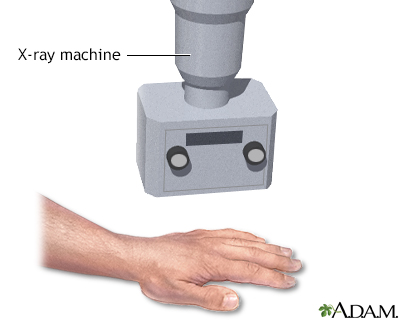Bone x-ray
X-ray - bone
A bone x-ray is an imaging test to look at the bones.
Images





How the Test is Performed
The test is done in a hospital radiology department or in your health care provider's office by an x-ray technician. For the test, you will position the bone to be x-rayed on the table. Pictures are then taken, and the bone is repositioned for different views.
How to Prepare for the Test
Tell your health care provider if you are pregnant. You must remove all jewelry for the x-ray.
How the Test will Feel
The x-rays are painless. Changing position for getting different views of the bone may be uncomfortable.
Why the Test is Performed
A bone x-ray is used to look for injuries or conditions affecting the bone.
What Abnormal Results Mean
Abnormal findings include:
- Fractures or broken bone
- Bone tumors
- Degenerative bone conditions
- Osteomyelitis (bone infection)
Additional conditions under which the test may be performed:
- Cystic fibrosis
- Multiple endocrine neoplasia (MEN) II
- Multiple myeloma
- Osgood-Schlatter disease
- Osteogenesis imperfecta
- Osteomalacia
- Paget's disease
- Primary hyperparathyroidism
- Rickets
Risks
There is low radiation exposure. X-ray machines are set to provide the smallest amount of radiation exposure needed to produce the image. Most experts feel that the risk is low compared with the benefits.
Children and the fetuses of pregnant women are more sensitive to the risks of the x-ray. A protective shield may be worn over areas not being scanned.
Related Information
X-rayBroken bone
Bone tumor
Osteomyelitis
Cystic fibrosis
Multiple endocrine neoplasia (MEN) II
Multiple myeloma
Osgood-Schlatter disease
Osteogenesis imperfecta
Osteomalacia
Paget disease of the bone
Rickets
References
Contreras F, Perez J, Jose J. Imaging overview. In: Miller MD, Thompson SR. eds. DeLee, Drez, & Miller's Orthopaedic Sports Medicine. 5th ed. Philadelphia, PA: Elsevier; 2020:chap 7.
Kapoor G, Toms AP. Current status of imaging of the musculoskeletal system. In: Adam A, Dixon AK, Gillard JH, Schaefer-Prokop CM, eds. Grainger & Allison's Diagnostic Radiology: A Textbook of Medical Imaging. 7th ed. Philadelphia, PA: Elsevier; 2021:chap 38.
BACK TO TOPReview Date: 4/27/2023
Reviewed By: Linda J. Vorvick, MD, Clinical Professor, Department of Family Medicine, UW Medicine, School of Medicine, University of Washington, Seattle, WA. Also reviewed by David C. Dugdale, MD, Medical Director, Brenda Conaway, Editorial Director, and the A.D.A.M. Editorial team.

Health Content Provider
06/01/2025
|
A.D.A.M., Inc. is accredited by URAC, for Health Content Provider (www.urac.org). URAC's accreditation program is an independent audit to verify that A.D.A.M. follows rigorous standards of quality and accountability. A.D.A.M. is among the first to achieve this important distinction for online health information and services. Learn more about A.D.A.M.'s editorial policy, editorial process and privacy policy. A.D.A.M. is also a founding member of Hi-Ethics. This site complied with the HONcode standard for trustworthy health information from 1995 to 2022, after which HON (Health On the Net, a not-for-profit organization that promoted transparent and reliable health information online) was discontinued. |
The information provided herein should not be used during any medical emergency or for the diagnosis or treatment of any medical condition. A licensed medical professional should be consulted for diagnosis and treatment of any and all medical conditions. Links to other sites are provided for information only -- they do not constitute endorsements of those other sites. © 1997- 2025 A.D.A.M., a business unit of Ebix, Inc. Any duplication or distribution of the information contained herein is strictly prohibited.
